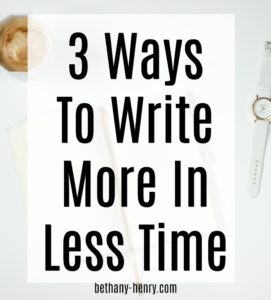 Wouldn’t it be nice to have hours upon hours to cozy up with our writing? To spread our notebooks across the grass and write the day away, or maybe claim a spot at the local coffee shop until the barista knows our drink order?
Wouldn’t it be nice to have hours upon hours to cozy up with our writing? To spread our notebooks across the grass and write the day away, or maybe claim a spot at the local coffee shop until the barista knows our drink order?
Honestly, sometimes I dream of having even five minutes to myself.
There are a million and three things clamoring for my attention daily. Dishes, dinner, places to be and things to do. Besides general life craziness, I have two small children who are frequently wriggling their way across my lap when I sit down to write. (I blame all my typos on them haha.)
Your to do list may be different than mine but I bet that the business is the same.
So how do we write when we simply don’t have time? We call ourselves writers (and we should!) but how do we actually go about writing?
As the ancient philosopher Lao Tzu said, “A journey of a thousand miles begins with a single step.”
On our writing journey we go one step at a time. One minute at a time if that’s all we have! (Usually I shoot for at least 5 minutes but hey, we take what we can get.)
Steps add up.
It’s time to imitate the tortoise from the classic story, the Tortoise and the Hare. Slow and steady, folks. If we keep moving slow and steady we will eventually win the race. It isn’t easy and it doesn’t happen by accident.
It takes intentionality. Focus. Dedication.
Here are 3 practices I’ve found helpful in turning scattered moments into successful writing times.

1. Make a Plan
This is probably my most useful tip which is why I put it right at the beginning for you 😉
Such a small thing really- it usually consists of just writing down a to do list. Simple! All I need is a sticky note and a pencil!
But can it be that easy?
As writers, we should know more than anyone the importance of writing things down. Yet I still sometimes find myself trying to remember what tasks I need to accomplish, or spending all of my meager writing time trying to get my thoughts organized.
If only I’d had a list maybe I would have gotten something done.
It doesn’t need to be a “to do” list if something else is more your style. It doesn’t need to be numbered or color coded.
The important bit is that you have a plan of what needs to get done. Ideally it can be broken down into small pieces so when you have a few moments you can look at it and see what needs to be done next. Maybe you need to research a name for your protagonist’s best friend. Maybe a fight scene needs to be blocked out. A scene needs to be outlined or a draft written. Maybe your papers need to be organized. One of the last tasks on my list today is to make my next to do list.
By breaking our writing (and non writing) tasks into organized items, we can easily see what comes next. This prevents us from wasting our precious time in dawdling over which item we feel like working on or sorting out where we are in a project.
But what about creative inspiration? Being immersed in the story? Letting the characters speak to me?
I hear you. And I hope your characters do speak to you. And I hope you do feel inspired.
But there is work to be done even if you don’t feel inspired.
If you have a weekend to spend alone with your writing, by all means take it. I’d still suggest making a plan though! Just because we may have more time doesn’t mean we should waste it by being indecisive or distracted.
Even if you never have large times set aside to write it is possible to get large amounts of writing accomplished. With practice you can train yourself to work effectively in short bursts amidst the other activities in your day.
I know everyone approaches writing differently- we have planners, pantsers, plantsers (any other terms out there??)- but you should find a format that works for you and plan as much as you’re able.
Your saved time and increased productivity will thank you.
And speaking of productivity, here’s another writing strategy..

2. Pomodoro Method/Set a Timer
The Pomodoro Method has been around a little while now but I’ve just discovered it recently and it’s super exciting! And remarkably effective.
It’s a time saving and productivity technique developed by Francesco Cirillo in the late 1980s with the tagline of “Work Smarter, Not Harder.”
Now that’s a slogan I can get behind!
The way the technique works is you pick a task to work on (from your shiny new “to do” list from tip 1 perhaps) and then set a timer for 25 minutes. This time is your “pomodoro.” You are promising to work on your chosen task without interruption for 25 minutes.
So you close the 27 other tabs on your computer and you write write write until… *ding!* your time is up.
Congratulations! You’ve completed your first pomodoro!
Next you get to take a short break. (Yay for breaks!) This break should be about 5 minutes. Take a walk. Make yourself some tea. Stretch.
And then (this is important!) you return to your writing space, decide which task to work on next, and start another pomodoro. After 4 pomodoros you get a longer break and you can repeat them all day! This technique can be used for any type of tasks, whatever needs to get done.
Cirillo’s website has more information but these are the basics. Whether your timer is always set for 25 minutes or something different (I frequently use 20 minute intervals myself) this is a GREAT way of keeping yourself on task and getting things done.
Park of what makes it so effective is the focus on staying… well, focused.
After all, it’s only 20 minutes. And the only tool you need is a timer. But wow do things get done.

3. Let It Go
(Now you all have Disney songs stuck in your head. You’re welcome.)
This last tip is probably one of the hardest strategies for my perfectionist self to accept.
Letting go here means allowing our writing to be incomplete or imperfect at times.
This is important because it gives us the freedom to write and create despite not having six hours to proofread and come up with the perfect title and the best examples and and and… you get the point.
It’s hard to be perfect. Our first (and even second, third, and twenty fourth) drafts will not be perfect.
I’m not saying we shouldn’t strive to be as good as we can be. We should always try to make everything the best it can be and challenge ourselves to grow and improve. (Learning when to turn things over to beta readers and publishers is a topic for another day.)
But this process takes time.
So when we are short on time it means we need to encourage ourselves to continue to create, to brainstorm, to simply WRITE- all with the promise of returning later to add to the story, polish our creation, and (we hope) to perfect it.
If we get caught up on making everything just how we envision it we can be stuck on our first paragraph for days. Instead of making it perfect we just need to make it better. And then next time we’ll continue to make it better.
For some people this is not a problem. There are days when I find it incredibly hard.
For proof that this strategy works though, just check out NaNoWriMo which boasts hundreds of thousands of novelists who complete drafts of their novels within ONE MONTH. That’s 30 days. This is not allowing time for perfection, people.
By encouraging writers to overcome their inner critic it allows us to move our writing forward. There is a time for us to be critical and nit picky with our writing. But many times we need to just get it done.
Participating in NaNoWriMo greatly improved and progressed my own writing and everyone should try it! (I’ll post more about it closer to November for anyone wanting to get involved so stay tuned.) Even if it’s not your cup of tea or November is a terrible time for you to sign up, I hope you’ll consider the mindset behind it.
Just do it. Get it written. Allow it to be terrible but get it on the page anyway.
At the end of the day you’ll have more than you started with and that’s a win, my friend 🙂
So these are my top 3 tips for writing in those scattered moments- are these things you already do or do you have your own tips to share? I’m always looking for more ways to make my time work for my writing!





One thought on “3 Ways To Write More In Less Time”
Comments are closed.